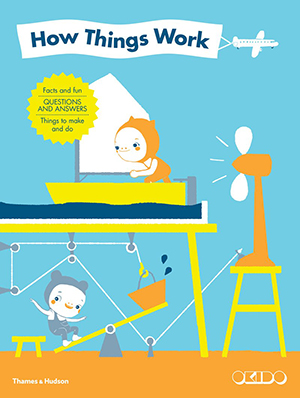[alert variation=”alert-info”]Publisher: Thames & Hudson
Formats: Hardcover
Purchase: Powell’s | Amazon | IndieBound | Barnes & Noble[/alert]
In this book, the writers at OKIDO, a British arts and sciences magazine for kids, have created a ragtag bunch of strange characters to help kids learn about science, the world, and a little bit of everything. There is Alex, who likes to build things, and Koko, who likes to take them apart. Then there are the explorers: a robot and two of what can only be described as cat-bears, who carry out the scientific method by observing, asking questions, and testing different hypotheses. Together, they guide kids through games, explain complex concepts in simple ways, and deliver a unique and childlike perspective on the world.
This book has a little bit of everything: board games, science experiments, I Spy games, infographics, comics, and hands-on activities are used to teach young readers about…well, everything. Topics covered include energy use, states of matter, how things are made, properties of sound and light, people and their occupations, languages of the world, transportation, types of simple machines…everything but the kitchen sink, and there might even be a kitchen sink somewhere in there, too.
The all-inclusive nature of the book is sometimes to its detriment, as some of the topics and activities don’t seem to fit (making a TV show? Weaving with a loom?). In addition, some of the playable board games in the book looked like they might get dull or frustrating to play—the occupations one seems impossible to win.
But the majority of the other activities did look like a lot of fun. What kid wouldn’t want to make a marshmallow catapult, make a model car, or use food coloring to see firsthand if oil and water mix? The illustrations are quirky and fun, and they manage to simplify ideas so that kids can grasp them easily. The messages throughout the book about conservation and sustainable living are effective, and not delivered in a preachy, moralistic way, which is sometimes hard to come by in a children’s book. In particular, one genius story about two tribes of robots beautifully illustrates the benefits of solar, wind power, and other sustainable energy sources instead of oil.
Although the book’s activities are uneven in terms of interest and the “fun” quotient, there will be something in the book for every child. Whether they want to learn some science magic they can do at home, play games, or just look at interesting pictures, kids will be able to find many things in How Things Work to entertain themselves.
[signoff predefined=”Social Media Reminder” icon=”twitter”][/signoff]

